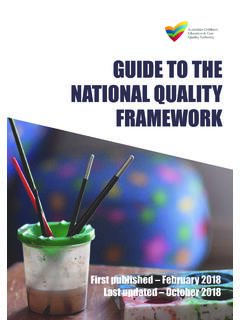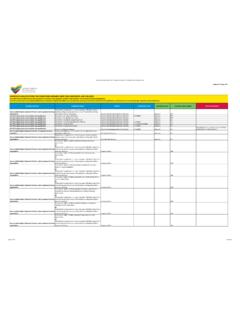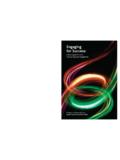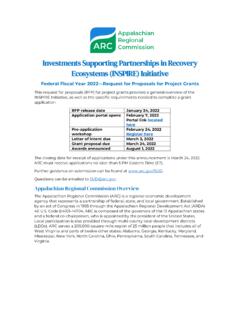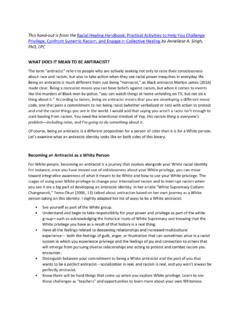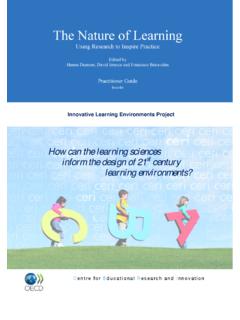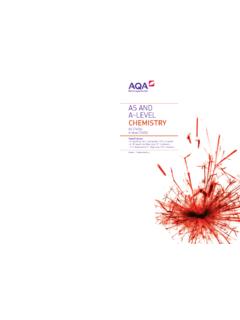Transcription of EDUCATORS - ACECQA
1 EDUCATORS . BELONGING, BEING & BECOMING. EDUCATORS ' Guide to the EARLY YEARS LEARNING. FRAMEWORK FOR AUSTRALIA. Produced by the Australian Government Department of Education, Employment and Workplace Relations for the Council of Australian Governments. Commonwealth of Australia 2010. ISBN 978-0-642-77918-2 [Print]. ISBN 978-0-642-77919-9 [PDF]. ISBN 978-0-642-77920-5 [RTF]. This work is copyright. Apart from any use as permitted under the Copyright Act 1968, no part may be reproduced by any process without prior written permission from the Commonwealth. Requests and inquiries concerning reproduction and rights should be addressed to the Commonwealth Copyright Administration, Attorney-General's Department, Robert Garran Offices, National Circuit, Barton ACT 2600 or posted at Contents 1. Introduction: using the Guide with the Framework 3. 2. Reflective practice for improvement 7. 3. Curriculum decision making: the key to implementing the Framework 10.
2 4. Linking beliefs and theoretical perspectives with practice: exploring the relationship between the Framework's Principles, Practice and learning Outcomes 14. 5. Partnerships: working with families and community 17. 6. Cultural competence 21. 7. The journey for EDUCATORS : growing competence in working with Australian Aboriginal and Torres Strait Islander cultures 24. 8. Learning through play 30. 9. Continuity of learning and transitions 34. 10. Assessment for learning 37. 11. Learning outcomes 42. 12. Glossary of terms 47. 13. References and resources 49. 14. The early years learning framework in action 58. EDUCATORS Belonging, Being & Becoming 1. Abbreviations used in this document: The Framework: Belonging, Being & Becoming: The Early Years Learning Framework for Australia The Guide: EDUCATORS Belonging, Being & Becoming: EDUCATORS ' Guide to the Early Years Learning Framework for Australia The Reflect Respect Relate resource or RRR: REFLECT RESPECT RELATE.
3 Assessing for learning and development in the early years using observation scales (2008, DECS). The terms used in the Guide are consistent with the Framework. For explanations see the definition boxes and glossary in the Framework. 2 EDUCATORS Belonging, Being & Becoming 1. Introduction: using the Guide with the Framework Belonging, Being & Becoming: the Early Years Learning Framework for Australia and EDUCATORS Belonging, Being & Becoming: EDUCATORS ' Guide to the Early Years Learning Framework for Australia are intended to support curriculum decision making to extend and enrich children's learning from birth to five years and through the transition to school (Framework, ). A new vision for Australia The Framework provides an opportunity for EDUCATORS across Australia to work towards: The Early Years Learning Framework is an important and timely resource for early childhood. a clear focus on children's learning and wellbeing It embraces a vision for a new Australia: a shared language for curriculum in the early a future that embraces all Australians childhood field a future based on mutual respect, mutual resolve a base for planning, promoting and and mutual responsibility assessing learning a future where all Australians, whatever their improved quality in early childhood settings origins, are truly equal partners, with equal cultural security for Aboriginal and Torres Strait opportunities and with an equal stake in shaping Islander children and their families the next chapter in the history of Australia.
4 Including families and communities in To this end, the Framework is built around a number children's learning. of key concepts and principles which require When starting to use the Framework remember EDUCATORS to use particular understandings and that it is just that a framework. It is not a syllabus, practices effectively to achieve the desired outcomes. not a program, not a curriculum, not a model, not This Guide will help EDUCATORS do this in their an assessment tool, not a detailed description of local settings. everything children will learn. It is a framework of A major feature that distinguishes Australia from all principles, practices and outcomes with which to other countries in the world is the ancestral build your curriculum. relatedness of Indigenous people. This relatedness It is based on the best available evidence and what is forms the world's oldest living culture. Acknowledgment socially and culturally important.
5 As such, some ideas of Indigenous ancestral relatedness, its values, and will be consistent with some of your practices and how these are realised is distinctly Australian. knowledge, and some will be challenging, new and The Council of Australian Governments is committed very particular to Australia. This provides excellent to closing the gap in educational achievements opportunities for all EDUCATORS to build on their between Indigenous and non-Indigenous Australians current knowledge and experience, so that their within a decade (Framework, ). curriculum decision making (both intuitive and reflective judgements) are consistent with current thinking and expectations. EDUCATORS Belonging, Being & Becoming 3. Both the Framework and the Guide are for early Respect for diversity underpins the Framework and childhood EDUCATORS in all Australian early childhood the Guide. Both documents recognise the diversity settings working in partnership with families and of EDUCATORS ': children and may complement, supplement or replace personal history, experiences and values settings' current frameworks.
6 The Guide provides professional pathways and qualifications support for individuals and collegial teams to use the beliefs about childhood, children, learning and Framework. curriculum A new vision for EDUCATORS journey and drive for cultural competence use of theoretical perspectives. There are several big bits to education. One is the curriculum (what we want people to learn); then there's teaching (how we help them to learn); and assessment Using the Guide (how we make judgements about how they are getting The Guide is designed to be used in interactive on).We focus on curriculum (usually maths, language, ways to promote in-depth conversations and thinking science), then assessment (usually standardised tests). over a sustained period about the concepts which The bit we leave out is the quality of teaching build the Framework. It is not intended to be read in Most reform systems are looking backwards; they're one sitting.
7 Rather, individuals and teams of EDUCATORS looking back to the old system that was the result of the may find it helpful to dip' into the Guide at different industrial no longer want a better steam points, to focus on one section at a time, and to need to get back to what drives begin with the section of most interest to them. people to learn and education is about kids Most readers will find it helpful to read the and energising them (Sir Ken Robinson, 2009). Framework before turning to the Guide. EDUCATORS Belonging, Being & Becoming, the EDUCATORS ' The following concepts of the Framework are Guide to support the use of the Framework, takes explored in the Guide: an approach that values EDUCATORS engaging in belonging, being and becoming and their links to professional growth leading to thoughtful judgement learning and decision making for all children's learning. Evidence shows that reflective practice can help principles, practices and pedagogy, including play EDUCATORS to think more deeply about their work and and partnerships with families, to support learning motivate them to explore new ideas and approaches reflective practice (see, for example, Anning & Edwards, 2006).
8 Curriculum decision making to foster children's The Framework and the Guide aim to embed learning in areas identified by five broad reflective practice and inquiry into EDUCATORS ' Learning Outcomes everyday practices. For EDUCATORS : facilitating children's transitions in the early years Belonging relates to connections and relationships developing cultural competence with other EDUCATORS and professionals from Australian Aboriginal and Torres Strait Islander other disciplines, participation in professional cultural competence organisations and networks, and community involvement. using theoretical perspectives. Being relates to the individuality of each early childhood educator and to the distinctiveness of each team of EDUCATORS . Individuals and groups bring a unique collection of beliefs, values, interests, knowledge, experience and perspectives to planning, practice and relationships. Becoming relates to the importance of learning and reflecting in order to increase professional knowledge and improve skills and practices.
9 4 EDUCATORS Belonging, Being & Becoming Both the Framework and the Guide are designed to Talk and reflect about includes reflective engage EDUCATORS in critical thinking, reflection and questions and suggestions for going deeper inquiry. As such they are not prescriptive or recipe' Try out possible entry points books but rather are intended to provoke, inspire Hear about stories and models of practice and challenge. They recognise that there is not one Find more about links to other resources. right way' to provide for children's learning. They provide a range of ways to think about children's Photos are included to illustrate the links between learning. If we think there is just one right way and if the Principles, Practice and Learning Outcomes. we have no doubt about the quality of our provision, Each section has a reference to the Reflect Respect we leave little room for reflection, for questioning or Relate resource which provides a guide for EDUCATORS for change.
10 To critically reflect on pedagogy and relationships The sections that follow this Introduction all have and the connection with children's wellbeing and a similar format. Each major section starts with a involvement in learning. quote from the Framework and then is divided into the following segments which help you to explore particular concepts in the Guide: Think about explanatory information about the section Elements of the Early Years Learning Framework ELONGING. B. rld wo om lved lbe eir S. SSeec Ge HighR oesmpm y ME. t e c nvo f wel iteos th ibu enti cuurr nic learn g ato ers in ee, r nuPianre eexspe cutnfiotyr prreafclet en hav adrtwicit rong TCO. d it e i n t rs of elsap npea On effe t an nse rm ildr are c a st phaatend sense PR danr pitsh w siteyq teioc rsthn taftoior tdoiveqr cteive are den g se onm OU. go t o ntfsuh ieprs ndsiv suiitt pra t IN decpipo faimthi uity en onf ron incco ing mu lipans shwi aenrd yy CR renfliencg CI rsoitciva lfiaems leRa G.



